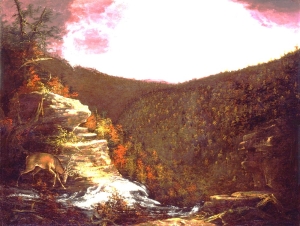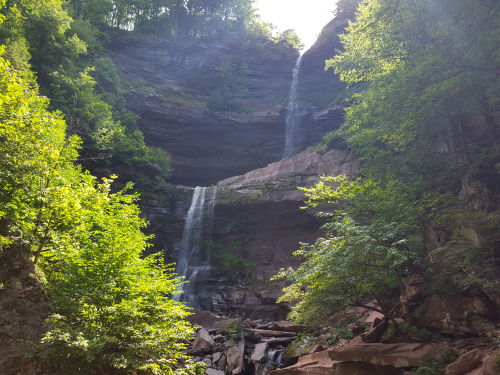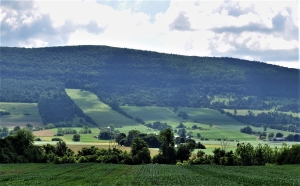The Art Trail – Part Five – Kaaterskill Falls -May 20, 2025
Hudson River Art Trail: Site Five, Kaaterskill Falls
Windows Through Time; The Daily Mail; Mar. 5, 2015
Robert and Johanna Titus
There are many locations along the Hudson Valley Art Trail but one is almost sacred. It is the top of Kaaterskill Falls. The site has been visited for more than two centuries. We have found one inscription carved into the rock there, which dates back to 1810. But the most historic day was likely in the autumn of 1825 when young Thomas Cole first came to visit this site. He was a budding artist, looking to find his way, to establish himself as a painter of landscapes. Cole must have been most impressed; he painted the view here. See our illustration. It and a few more he did in the area were the making of him – and the making of the Hudson River School of Art.

You can see the very same view. From Rte. 23A, take County. Rte. 18 east until you turn right onto Laurel House Road. Park at the end of the road and then walk down the dirt trail another quarter mile to the top of the falls. Walk out only as far as is prudent and look down the canyon below. It is a narrow defile, cut by erosion, mostly during the last few tens of thousands of years. You can stand exactly where Cole stood when he sketched the site. As we said, it is a sacred location.
We don’t know how many times we have been there. We are drawn to this place. We imagine that all of the artists of the Hudson River School came here as well. Climb up on the great boulder that is perched at the edge of the falls and if you look around, you will find the name Sanford Robinson Gifford cut into the rock. Gifford is one of our favorite Hudson River artists; we were thrilled to see his name here.
All of those artists saw the falls as they are today; the view has not changed. They were most often called to this spot in the autumn when the colors are so good. They must, all of them, have been very pleased to see and then paint what they saw.
But we are different, we are geologists who are drawn to all the same locations with a strong need to see them not as they are, but as they were: specifically, as they were during the Ice Age. Our thesis, in this series, has been that the Hudson River artists painted landscapes that were sculpted by ice age processes. When we go to see these sites, we travel with the mind’s eye to see them as they were. But the mind’s eye must rely on the evidence that feeds it images from the glacial past. We have gathered that information the hard way, on foot.
Now we have learned enough to return to the top of the ice age falls and see it as it was. We stand at the precise same spot where Thomas Cole too would someday stand. Before us are all the hills that rise above the canyon and the more distant clove. But this is the Ice Age, and all of those hill slopes are bare. Not a single tree is to be seen. We hear sharp cracking sounds, along with loud pops and prolonged groans. We look down. There, below us, is a glacier, a stream of ice. We can’t see it move, but it is a very active lobe of ice. It is being pushed from behind. Farther down below, it is being shoved by more ice, ice ascending from Kaaterskill Clove. Behind that even more ice, a lot more ice, is pushing the clove’s frozen stream. That is the ice of the south moving Hudson Valley glacier.
On this sullen and overcast day the colors are muted, but the image is spectacular. An enormous complex of icy streams is flooding all the valleys around here and sculpting, gouging, and carving a landscape that painters will someday turn into great art.
Contact the authors at randjtitus@prodigy.net. Join their facebook page “The Catskill Geologist.”

